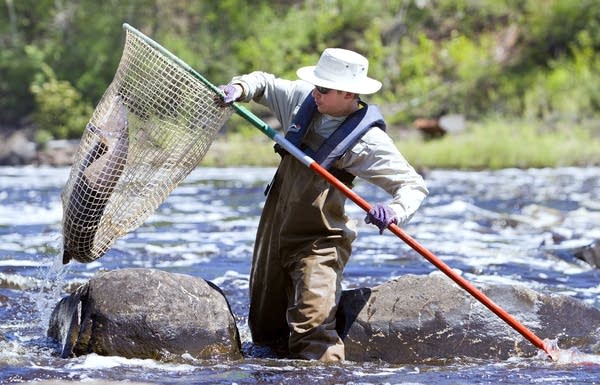DNR restructures in hopes of better water protection

The state Department of Natural Resources is merging two of its divisions, a change the agency says will result in better protection for the states lakes and rivers.
The DNR is combining the divisions of waters and ecological resources into one as yet unnamed division that will focus on water quality.
KEEPING UP WITH CHANGING STATE
Ecological Resources Division Director Steve Hirsch said the state is changing in terms of climate, population and development pressure. The DNR needs to be more responsive to those changes, he said.
Create a More Connected Minnesota
MPR News is your trusted resource for the news you need. With your support, MPR News brings accessible, courageous journalism and authentic conversation to everyone - free of paywalls and barriers. Your gift makes a difference.
"We're looking at a pace of change and the challenges it's producing in the natural resources field is unprecedented for people that are working in this field, Hirsch said. "So we need to make sure our programs are relevant as this change unfolds."
Voter approval of the legacy amendment, a tax earmarked for environmental protection, was a strong sign Minnesotans want to protect lakes, streams and biodiversity, he said.
As land use, including new homes or businesses near lakes, affects water quality, the new division will bring together experts in both areas. They will focus on management of entire watersheds, not just individual lakes and streams.
Hirsch said collaboration will be a major focus of the new division.
He said regulation and enforcement are good tools for protecting water. But he said budget cuts limit the enforcement the agency can do, so more regulation is not the answer.
"We need to be effective beyond the reach of our regulatory programs and just the land that we own," he said. "So that's going to be a real focus of this new division ... to try to be more effective in how we work with our partners and provide information to our partners to influence better land and water use decisions."
Hirsch says the DNR collects a lot of data about land use and water quality. But he says that science isn't always shared with the people who are making decisions about land use -- decisions that often affect lakes and rivers.
In the future, the DNR will make sure county commissioners or developers use that science to make decisions about development.
SKEPTICISM OVER MERGER
St. Louis County commissioner Dennis Fink said DNR science is often critical to decisions the county makes about land use, so he would welcome a stronger collaboration with the agency. But he also us skeptical of the change.
"I'm always concerned when folks at the state or federal government say we're here to help and then tell us that we're responsible for doing it their way," he said.
Fink said his primary concern is the focus on watershed management. Watersheds don't respect county boundaries and rivers often meander across several counties. Under the current regulatory arrangement, individual counties make decisions about land use.
"If you move away from that and create a new management structure, which combines five or six counties, then the question becomes what's the value of the local unit of government as we know it today," Fink said.
He said counties would lose some of their autonomy if all counties in a watershed would be required to adopt the same land use regulations.
Crow Wing County Commissioner Paul Theide said he agrees with the idea that protecting water quality requires education and cooperation, not just regulation.
But Theide said all the new money generated by the legacy amendment might be driving some changes just for the sake of change.
"The current paradigm, if you will, is innovation," Theide said. "We've got to find innovative new ways to spend these dollars that are available for water protection ... I think if we also did a better job of documenting what works and what doesn't work we could do a better job of resolving differences between these agencies."
ENVIRONMENTAL GROUPS WITHHOLD JUDGMENT
Environmental groups are also taking a wait and see attitude to the DNR restructuring.
Henry Van Offelen, a natural resource scientist for the Minnesota Center for Environmental Advocacy, said if the merger of two division is done right, the result will be better management and better oversight of Minnesota waters.
But Van Offelen said the DNR has not adequately enforced regulations to protect lakes and streams. He said if the new division continues the trend, it will be a failure.
"If the merger is going to result in more of the same sort of activity we've seen the past five years or ten years, then I think 20 years from now we'll be left with really good documentation and understanding of why we have significant resource declines," he said. "But we will not have stopped those declines."
Van Offelen says he will judge the DNR on the quality of Minnesota lakes and streams five or 10 years from now.
That's the same measure of success used by Hirsch. He said it will take at least a year for the new division to get refocused.
